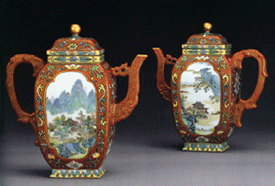When Was
-
The Teapot Invented?
By Mike McLeod
Actually, the first question to answer is: when was tea discovered? The
legend goes that in the Year 2737 BC, tea leaves from the Camellia Sinensis tree
floated into a bowl of water boiling for Shen Nung, Emperor of China. Finding
the taste pleasing, the Emperor continued to drink "tay," and the practice
spread to India, Thailand and eventually to Japan in the 9th century. It was
thought of a medicinal drink at first.
|

|
Hot pots: the $1.26 million
Famille Rose Coral-Ground teapots,
the most
expensive ever sold.
(Photo, courtesy Christie's.) |
Tea did not reach Europe until 1610
when Dutch traders brought it back to Holland. Today, it is the drink of choice
of the British and many throughout Europe.
The invention of the teapot lagged
behind the discovery of tea. From about the 8th century, the leaves shredded
and then powdered were boiled in bowls and sometimes whipped to make tea.
Various sources report the first teapots appearing during the Sung Dynasty
(960-1279) or the Ming Dynasty (1368-1644), but virtually all agree they first
came from the YiXing (pronounced "ee-shing") region of China, about 120 miles
northwest of Shanghai. There, a purple clay known as "zisha" was formed into the
first small pots.
These teapots were made to brew only one or two servings of
tea, which was drunk directly from the spout. At the time, people carried their
own personal pots for brewing and drinking tea.
Larger pots came into use
some time later. Europeans eventually used their Arabic coffeepots for brewing
tea. While silver tea services were used by the upper crust starting in the
1700s, stoneware pots were most commonly used. The Asians dominated world trade
in the thin-walled and beautifully decorated kaolin porcelain pots. It wasn't
until Johann Bottger of Meissen, working for the King Augustus of Poland as an
alchemist, discovered how to make hard-paste porcelain that smooth, white
teapots were made on the Continent.
Teapots and teacups are favorite
collectibles for their beauty, elegance and variety. In addition, most are quite
affordable except for a pair sold by Christie's in 2000. The coral-ground
teapots from the Qianlong Period (1736-1795) sold for $1,264,629.
As an
aside, iced tea was invented in 1904 at the St. Louis World's Fair. The stifling
heat prevented anyone from drinking hot tea, so the beverage was cooled down,
and gallons were drunk.
Teabags were invented a few years later, which
removed the need for teapots. However, teabags did not destroy the desire to own
these lovely pots.
|